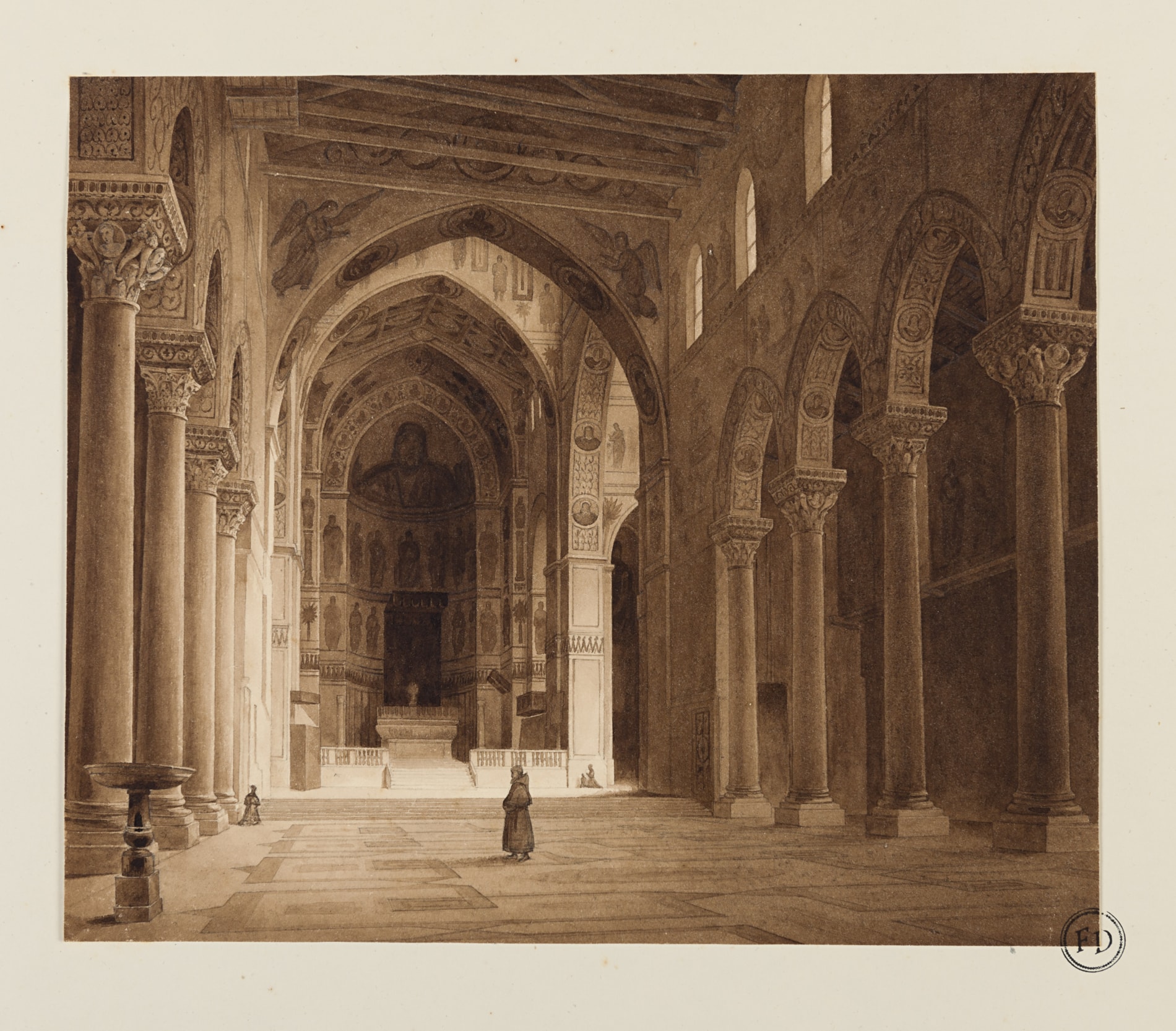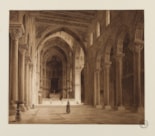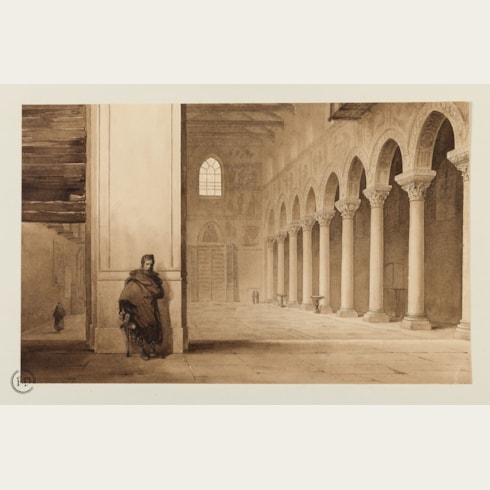Joseph-Frédéric DEBACQ
(Paris 1800 - Paris 1892)
The Nave of the Cathedral at Monreale, Looking Towards the Apse
Pen and brown ink and brown wash, over an underdrawing in pencil.
Inscribed Cathedrale de Monreale près de Palerme on the verso.
Further inscribed Cathedrale de Monreale près Palerme. at the bottom of the album page onto which this drawing was pasted.
Stamped with the mark FD in a double circle (not in Lugt), possibly the Debacq atelier stamp, at the lower right.
238 x 283 mm. (9 3/8 x 11 1/8 in.)
Inscribed Cathedrale de Monreale près de Palerme on the verso.
Further inscribed Cathedrale de Monreale près Palerme. at the bottom of the album page onto which this drawing was pasted.
Stamped with the mark FD in a double circle (not in Lugt), possibly the Debacq atelier stamp, at the lower right.
238 x 283 mm. (9 3/8 x 11 1/8 in.)
This drawing was once part of an album of pen and wash drawings – executed by both Joseph-Frédéric Debacq and the Duc de Luynes - of landscape views and architectural sites, made during their journey together through Italy in 1828. The two men began their voyage in Savoy in the south of France, and travelled across the Alps and through Piacenza, Rimini, Fano and Narni to Rome. They then continued their trip, via Terracina, to Naples, Pompeii and Paestum, thence to Metaponte and Taranto, and onwards to Gerace in Calabria. On the island of Sicily Debacq and de Luynes visited Taormina, Syracuse, Agrigento, Selinunte, Segesta, Palermo and Monreale.
One of the finest surviving examples of Norman architecture, the Cathedral, or Duomo, of Monreale in Sicily was founded by King William II of Sicily and built between 1174 and 1267 AD. Much of the vast interior, with a wide central nave flanked by two smaller aisles, is decorated with some 6,400 square metres of golden mosaics depicting scenes from the Old and New Testament, executed between the late 12th and mid 13th centuries by local craftsmen and artists from Venice and Constantinople. These Byzantine-style mosaics are among the finest in existence.
This drawing presents a view of the nave of the Duomo, looking west towards the triple apse, which is dominated by the monumental mosaic of Christ Pantocrator over the altar. As the British traveller and writer Henry Gally Knight describes the scene, ‘nothing can less resemble the interior of Norman churches in the north than the interior of Monreale. Here are no massive buttresses, no round arches, no triforium. Single pillars, taken from Roman buildings, support pointed arches on each side of the nave. Some of the capitals are antique, but the greater part are of the time, and of the same pattern, exhibiting foliage, volutes in the shape of cornucopias, with figures intermixed. These capitals are of the most delicate and elaborate workmanship, and can only have been produced by a Greek chisel…But the glory of Monreale consists in the Mosaics which cover its walls: the walls of the nave, of the aisles, the transepts, the apses - every part of this spacious cathedral. In the centre apse appears the leading feature of the interior – a colossal half length of the Redeemer, environed by the vision of the Apocalypse and the Apostles...All of these Mosaics are on a gold ground, and the whole affords the most gorgeous display of Byzantine decoration now in existence.’
One of the finest surviving examples of Norman architecture, the Cathedral, or Duomo, of Monreale in Sicily was founded by King William II of Sicily and built between 1174 and 1267 AD. Much of the vast interior, with a wide central nave flanked by two smaller aisles, is decorated with some 6,400 square metres of golden mosaics depicting scenes from the Old and New Testament, executed between the late 12th and mid 13th centuries by local craftsmen and artists from Venice and Constantinople. These Byzantine-style mosaics are among the finest in existence.
This drawing presents a view of the nave of the Duomo, looking west towards the triple apse, which is dominated by the monumental mosaic of Christ Pantocrator over the altar. As the British traveller and writer Henry Gally Knight describes the scene, ‘nothing can less resemble the interior of Norman churches in the north than the interior of Monreale. Here are no massive buttresses, no round arches, no triforium. Single pillars, taken from Roman buildings, support pointed arches on each side of the nave. Some of the capitals are antique, but the greater part are of the time, and of the same pattern, exhibiting foliage, volutes in the shape of cornucopias, with figures intermixed. These capitals are of the most delicate and elaborate workmanship, and can only have been produced by a Greek chisel…But the glory of Monreale consists in the Mosaics which cover its walls: the walls of the nave, of the aisles, the transepts, the apses - every part of this spacious cathedral. In the centre apse appears the leading feature of the interior – a colossal half length of the Redeemer, environed by the vision of the Apocalypse and the Apostles...All of these Mosaics are on a gold ground, and the whole affords the most gorgeous display of Byzantine decoration now in existence.’
An architect and painter, Joseph-Frédéric Debacq entered the Ecole des Beaux-Arts in 1818, studying with the architect Lucien-Tirté van Clemputte. Appointed architect to the city of Paris, Debacq found an important patron and supporter in Honoré Théodoric d’Albert de Luynes, the future 8th Duc de Luynes (1802-1867), a wealthy student of archaeology and an amateur artist. De Luynes was fascinated by antiquity, and in 1828 he and Debacq travelled together from southern France, across the Alps and through the Italian peninsula, to study the Greek ruins and cities of Southern Italy; the area known by the ancient Romans as Magna Graecia. In 1833 De Luynes would publish an important study, illustrated by Debacq, of the ancient Greek city of Metapontum in the Kingdom of the Two Sicilies. Working with the architect Charles Garnier, Debacq later designed the funerary chapel of the Château de Dampierre for the Duc de Luynes, and also built his hôtel particulier on the rue de l’Université in Paris.
Provenance
From an album of landscape drawings by Joseph-Frédéric Debacq and the Duc de Luynes, made during a voyage to southern Italy in 1828.





